How to ask for time in Arabic?
In this Arabic lesson, we are going to learn how to tell the time to the hour and minute in Arabic.
If you would like to ask someone for the time in Arabic, you should either say:
1- “kami as-sā’ah?” كم الساعة؟ (What time is it?)
or
2- “kami as-sā’ah al-ān?” كم الساعة الأن؟ (What time is it now?).
I personally recommend the second version for the following reason: The word “kam” كم in Arabic is often used, in interrogative phrases, to ask about the price of something. In this case, كم الساعة؟ might easily be understood as if you were asking about the price of the watch itself (How much is the watch?). The additional word “al-ān” الأن , which means “now” in English, makes it clear to the person, whom you are asking, that you’re referring to the current time not the price of his or her watch.
Unlike in some other languages, such as Spanish and Italian, where you might have to use different forms, depending on whether the time is within the 1 o’clock hour or if it’s after 1 o’clock, in Arabic, the form will always be the same. So, here are the forms you would want to use to tell someone what time it is in Arabic:
Forms to tell time in Arabic
1- innaha … – إنها ...
2- innaha as-sā’ah … – إنها الساعة ...
3- as-sā’atu tushiru ila … – الساعة تشير الى ...

N.B: All forms are correct. However, we are only going to use the 1st and 2nd ones here, since these are the most widely used expressions when answering a question about the current time. The last form is more of a way to announce time, which you’re most likely to hear on an Arabic radio station, TV, airport, or train station, etc… Also, keep in mind that you can tell the time directly w/o any introductions.
N.B: Depending on which Arabic country you’re in or planning to visit, you may either see the 12-hour clock being used the 24-hour clock, or both. Anyway, what you should know is that:
– “AM” in Arabic is translated as “qabla az-zawāl” قبل الزوال
and
– “PM” in Arabic is translated as “ba’da az-zawāl” بعد الزوال .
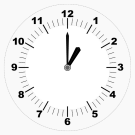 | 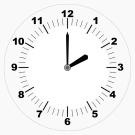 | 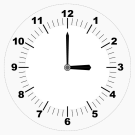 | 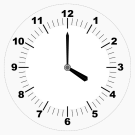 |
| One O’clock | Two O’clock | Three O’clock | Four O’clock |
| الساعة الواحدة | الساعة الثانية | الساعة الثالثة | الساعة الرابعة |
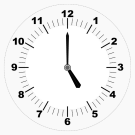 | 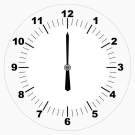 | 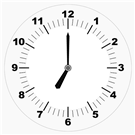 | 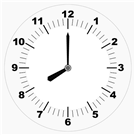 |
| Five O’clock | Six O’clock | Seven O’clock | Eight O’clock |
| الساعة الخامسة | الساعة السادسة | الساعة السابعة | الساعة الثامنة |
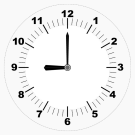 | 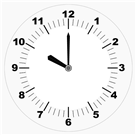 | 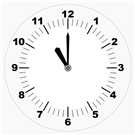 | 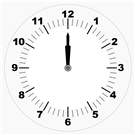 |
| Nine O’clock | Ten O’clock | Eleven O’clock | Twelve O’clock |
| الساعة التاسعة | الساعة العاشرة | الساعة الحادية عشر | الساعة الثانية عشر |
Now, to express the time after the hour, use “wa” و (and) and the number of minutes. However, there are some exceptions to be aware of here.
A- For the first minute after the hour, there are two ways to do that:
- Simply using the word “daqīqah” دقيقة which means “a minute”
– It’s 5:01 – إنها الساعة الخامسة و دقيقة - Using the word “daqīqah” دقيقة and adding the emphasizing word “wāhidah” واحدة which is the feminine translation for “one” in Arabic (ie: daqīqah wāhidah دقيقة واحدة )
– It’s 5:01 – إنها الساعة الخامسة و دقيقة واحدة
B- The same rule goes for the second minute after the hour:
- Simply using the word “daqīqatān” دقيقتان which means “two minutes”
– It’s 5:02 – إنها الساعة الخامسة و دقيقتان - Using the word “daqīqatāni” دقيقتان and adding the emphasizing word “itnatān” إتنتان which is the feminine translation for “two” in Arabic (ie: daqīqatāni itnatān دقيقتان إتنتان )
– It’s 5:02 – إنها الساعة الخامسة و دقيقتان إتنتان
C- From the 3rd minute after the hour till the 10th:
- Using the number of minutes first followed by the word “daqā’iq” دقائق which is the equivalent to the word “minutes” (plural)
– It’s 5:03 – إنها الساعة الخامسة و ثلاث دقائق
– It’s 5:04 – إنها الساعة الخامسة و أربع دقائق
– It’s 5:05 – إنها الساعة الخامسة و خمس دقائق
– It’s 5:06 – إنها الساعة الخامسة و ست دقائق
– It’s 5:07 – إنها الساعة الخامسة و سبع دقائق
– It’s 5:08 – إنها الساعة الخامسة و ثمان دقائق
– It’s 5:09 – إنها الساعة الخامسة و تسع دقائق
– It’s 5:10 – إنها الساعة الخامسة و عشر دقائق - Using the word “daqīqah” دقيقة followed by the Arabic ordinal number of minutes in definite form.
– It’s 5:03 – إنها الساعة الخامسة و الدقيقة الثالثة
– It’s 5:04 – إنها الساعة الخامسة و الدقيقة الرابعة
– It’s 5:05 – إنها الساعة الخامسة و الدقيقة الخامسة
– It’s 5:06 – إنها الساعة الخامسة و الدقيقة السادسة
– It’s 5:07 – إنها الساعة الخامسة و الدقيقة السابعة
– It’s 5:08 – إنها الساعة الخامسة و الدقيقة الثامنة
– It’s 5:09 – إنها الساعة الخامسة و الدقيقة التاسعة
– It’s 5:10 – إنها الساعة الخامسة و الدقيقة العاشرة
D- From the 11th minute after the hour till the 59th:
- Using the number of minutes first followed by the word “daqīqah” دقيقة .
– It’s 5:11 – إنها الساعة الخامسة و إحدى عشر دقيقة
– It’s 5:25 – إنها الساعة الخامسة و خمسة و عشرون دقيقة
– It’s 5:35 – إنها الساعة الخامسة و خمسة و ثلاثون دقيقة - Using the word “daqīqah” دقيقة followed by the Arabic ordinal number of minutes in definite form.
– It’s 5:11 – إنها الساعة الخامسة و الدقيقة الحادية عشر
– It’s 5:25 – إنها الساعة الخامسة و الدقيقة الخامسة و العشرون
– It’s 5:35 – إنها الساعة الخامسة و الدقيقة الخامسة و الثلاثون
C- For quarter, twenty, and half past the hour, here is the shortcuts:
– Quarter past – والربع as in 5:15 إنها الخامسة و الربع
– Twenty past – والثلث as in 5:20 إنها الخامسة و الثلث
– Half past – والنصف as in 5:30 إنها الخامسة و النصف
When expressing the time left to the next hour (only after half past the hour), use the term “illa” إلا :
- It’s 4:40 (20 to 5:00) – إنها الساعة الخامسة إلا الثلث
- It’s 4:45 (15 to 5:00)- إنها الساعة الخامسة إلا الربع
- It’s 4:50 (10 to 5:00)- إنها الساعة الخامسة إلا عشر دقائق
- It’s 4:55 (5 to 5:00)- إنها الساعة الخامسة إلا خمس دقائق
- It’s 4:58 (2 to 5:00)- إنها الساعة الخامسة إلا دقيقتين
- It’s 4:59 (1 to 5:00)- إنها الساعة الخامسة إلا دقيقة

Totally brilliant. But I am learning Arabic, so I need the accents, to indicate and determine the cases (genitive, accusative…)
In the future, if this is possible, thanks a million!
mumtaz
I’ll try. I had a bunch of subjects that I thought would be helpful, I just can’t find the time to write anymore. With that being said, I’m going to do my best :). I’m also buying some more pictures to keep things professional.
Best.
I like your lesson and really really want to master it.
please make another/new arabic lesson.
Thank you Muhammad, I’m glad you liked it!
Your link about telling time in arabic found very help full Thank you very much .
Hi Usaamah,I think you’ve just missed it w/in this article. It’s listed right before the table and next to the picture.
– “AM” in Arabic is translated as “qabla az-zawāl” قبل الزوال
and
– “PM” in Arabic is translated as “ba’da az-zawāl” بعد الزوال.
Could you add on what you say for am and pm as i would like to know